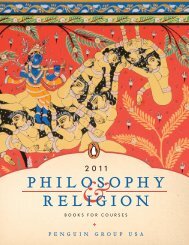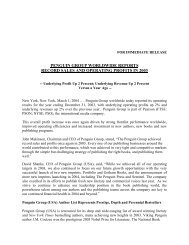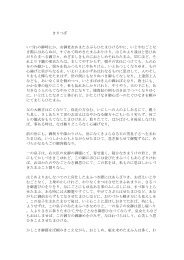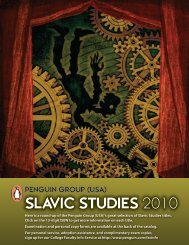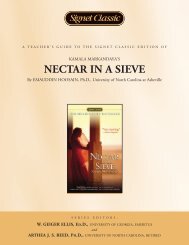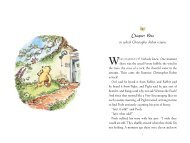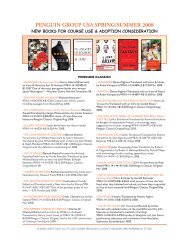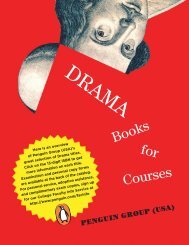KHALED HOSSEINI - Penguin Group
KHALED HOSSEINI - Penguin Group
KHALED HOSSEINI - Penguin Group
You also want an ePaper? Increase the reach of your titles
YUMPU automatically turns print PDFs into web optimized ePapers that Google loves.
or web “scrap book” of the main facts they discover<br />
about the landmine problem and its impact on the<br />
citizens of Afghanistan.<br />
5. Throughout the novel, readers are reminded of Afghanistan’s<br />
ethnic diversity. For example, when Mariam<br />
is forced to marry Rasheed, her father’s wives assure<br />
her that he speaks Farsi even though he is a<br />
Pashtun. Mariam is a Tajik. Students can read about<br />
the different people who make up the ethnic diversity<br />
of Afghanistan at:<br />
BEFORE READING<br />
1. A Thousand Splendid Suns takes its title from a poem<br />
by the 17th century Persian poet Saib-e-Tabrizi which<br />
can be found at this site:<br />
http://www.afghan-network.net/Culture/kabul_<br />
poem.html<br />
Ask students to read the poem and make a list of the<br />
images the poet uses to praise the city of Kabul. Ask<br />
students if they have read other poems of praise,<br />
called odes. You might ask if they have read the odes<br />
of the Romantic poets: Keats’ “Ode on a Grecian<br />
Urn” or Shelley’s “Ode to the West Wind.” An ode<br />
uses hyperbole and inflated language to glorify and<br />
enhance the subject and to create feelings of appreciation<br />
in the listener.<br />
Discuss: What do you learn about Kabul from reading<br />
this poem? What is your favorite image in this<br />
poem? What is the poet’s purpose? Does the poet<br />
succeed in creating a sense of the beauty of Kabul?<br />
2. Although Afghanistan is very much in the news, students<br />
may have a vague understanding of the history<br />
of the war since 2001 and the impact upon the citi-<br />
THEMES<br />
Students may explore the following themes while reading<br />
the novel:<br />
• Man’s inhumanity to man<br />
• Systematic victimization of women by patriarchal<br />
institutions<br />
• Spousal abuse<br />
• Resistance to victimization<br />
• Power of education<br />
• Education for women<br />
• Corrupting influence of absolute power<br />
http://www.pbs.org/newshour/indepth_coverage/<br />
asia/afghanistan/map_flash.html<br />
A Lesson Plan at this web site provides useful graphics,<br />
representing the distribution of ethnic groups. Ask<br />
students to note references to ethnicity as they read.<br />
Is the ethnic difference negative or positive? Are people<br />
treated differently because of their ethnicity? How do<br />
these perceptions affect people’s interactions? What<br />
other barriers to national unity are evident in Hosseini’s<br />
description of the people and their history?<br />
zens of this country. Ask students to read and make a<br />
list of what they learn from current news stories about<br />
the war in Afghanistan, the current political situation,<br />
and other issues confronting the people. Post<br />
these lists for students to review as they read the novel.<br />
Discuss how the situation is changing for the people.<br />
Is it improving or getting worse? After students<br />
have reviewed the news stories, discuss their sense of<br />
the future of Afghanistan. What are the problems<br />
facing the nation? Do they see things improving and<br />
in what ways?<br />
3. Both Mariam and Laila are victims of spousal abuse.<br />
Before reading the novel, ask students to read one or<br />
more articles on identifying the signs of spousal<br />
abuse, such as this list of the classic signs and symptoms<br />
of abuse at:<br />
http://www.abusefacts.com/articles/Classic.php<br />
Make a chart outlining the roles of the abuser and<br />
the abused. Post this chart so that as students read,<br />
they can identify and note plot events that match<br />
these signs of abuse.<br />
Introduce students to this list of themes and make sure<br />
that they understand what each theme means. Ask students<br />
to note particular themes in their reading journals<br />
or on post-it notes as they read the novel. After students<br />
have read several chapters, ask them to review their journal<br />
or post-it notes to identify what they consider the<br />
main theme of this particular section of the novel. List<br />
the theme(s) on a large chart and brainstorm the author’s<br />
possible meanings. Ask students: What is happening?<br />
Why is it important or significant? What does it mean?<br />
What is the author saying about this theme?<br />
3 A STUDY GUIDE TO <strong>KHALED</strong> <strong>HOSSEINI</strong>’S A THOUSAND SPLENDID SUNS




